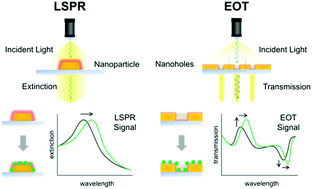当前位置:
X-MOL 学术
›
Chem. Soc. Rev.
›
论文详情
Our official English website, www.x-mol.net, welcomes your feedback! (Note: you will need to create a separate account there.)
Nanoplasmonic sensors for biointerfacial science
Chemical Society Reviews ( IF 46.2 ) Pub Date : 2017-04-06 00:00:00 , DOI: 10.1039/c6cs00494f Joshua A. Jackman 1, 2, 3, 3, 4 , Abdul Rahim Ferhan 1, 2, 3, 3, 4 , Nam-Joon Cho 1, 2, 3, 3, 4
Chemical Society Reviews ( IF 46.2 ) Pub Date : 2017-04-06 00:00:00 , DOI: 10.1039/c6cs00494f Joshua A. Jackman 1, 2, 3, 3, 4 , Abdul Rahim Ferhan 1, 2, 3, 3, 4 , Nam-Joon Cho 1, 2, 3, 3, 4
Affiliation

|
In recent years, nanoplasmonic sensors have become widely used for the label-free detection of biomolecules across medical, biotechnology, and environmental science applications. To date, many nanoplasmonic sensing strategies have been developed with outstanding measurement capabilities, enabling detection down to the single-molecule level. One of the most promising directions has been surface-based nanoplasmonic sensors, and the potential of such technologies is still emerging. Going beyond detection, surface-based nanoplasmonic sensors open the door to enhanced, quantitative measurement capabilities across the biointerfacial sciences by taking advantage of high surface sensitivity that pairs well with the size of medically important biomacromolecules and biological particulates such as viruses and exosomes. The goal of this review is to introduce the latest advances in nanoplasmonic sensors for the biointerfacial sciences, including ongoing development of nanoparticle and nanohole arrays for exploring different classes of biomacromolecules interacting at solid–liquid interfaces. The measurement principles for nanoplasmonic sensors based on utilizing the localized surface plasmon resonance (LSPR) and extraordinary optical transmission (EOT) phenomena are first introduced. The following sections are then categorized around different themes within the biointerfacial sciences, specifically protein binding and conformational changes, lipid membrane fabrication, membrane–protein interactions, exosome and virus detection and analysis, and probing nucleic acid conformations and binding interactions. Across these themes, we discuss the growing trend to utilize nanoplasmonic sensors for advanced measurement capabilities, including positional sensing, biomacromolecular conformation analysis, and real-time kinetic monitoring of complex biological interactions. Altogether, these advances highlight the rich potential of nanoplasmonic sensors and the future growth prospects of the community as a whole. With ongoing development of commercial nanoplasmonic sensors and analytical models to interpret corresponding measurement data in the context of biologically relevant interactions, there is significant opportunity to utilize nanoplasmonic sensing strategies for not only fundamental biointerfacial science, but also translational science applications related to clinical medicine and pharmaceutical drug development among countless possibilities.
中文翻译:

用于生物界面科学的纳米等离子体传感器
近年来,纳米等离子体传感器已被广泛用于医疗,生物技术和环境科学应用中的无标记生物分子检测。迄今为止,已开发出许多具有出色测量能力的纳米等离子体传感策略,可将检测范围降至单分子水平。基于表面的纳米等离子体传感器是最有前途的方向之一,这种技术的潜力仍在不断显现。基于检测的表面型纳米等离子体传感器通过利用高表面灵敏度与医学上重要的生物大分子以及诸如病毒和外泌体等生物微粒的大小相匹配的优势,为跨生物界面科学的增强的定量测量能力打开了大门。这篇综述的目的是介绍用于生物界面科学的纳米等离子体传感器的最新进展,包括纳米颗粒和纳米孔阵列的不断开发,以探索在固液界面相互作用的不同种类的生物大分子。首先介绍了基于局部表面等离子体共振(LSPR)和非凡光学传输(EOT)现象的纳米等离子体传感器的测量原理。然后,以下部分围绕生物界面科学中的不同主题进行分类,特别是蛋白质结合和构象变化,脂质膜制造,膜与蛋白质相互作用,外来体和病毒检测和分析,以及探测核酸构象和结合相互作用。在这些主题中,我们讨论了利用纳米等离子体传感器实现高级测量功能(包括位置传感,生物大分子构象分析以及复杂生物相互作用的实时动力学监测)的增长趋势。总而言之,这些进步突显了纳米等离子体传感器的巨大潜力以及整个社区的未来发展前景。随着商用纳米等离子体传感器和分析模型的不断发展,以在生物学相关相互作用的背景下解释相应的测量数据,存在巨大的机会将纳米等离子体传感策略不仅用于基础生物界面科学,而且还用于与临床医学和药物相关的转化科学应用药物开发有无数种可能性。
更新日期:2017-05-04
中文翻译:

用于生物界面科学的纳米等离子体传感器
近年来,纳米等离子体传感器已被广泛用于医疗,生物技术和环境科学应用中的无标记生物分子检测。迄今为止,已开发出许多具有出色测量能力的纳米等离子体传感策略,可将检测范围降至单分子水平。基于表面的纳米等离子体传感器是最有前途的方向之一,这种技术的潜力仍在不断显现。基于检测的表面型纳米等离子体传感器通过利用高表面灵敏度与医学上重要的生物大分子以及诸如病毒和外泌体等生物微粒的大小相匹配的优势,为跨生物界面科学的增强的定量测量能力打开了大门。这篇综述的目的是介绍用于生物界面科学的纳米等离子体传感器的最新进展,包括纳米颗粒和纳米孔阵列的不断开发,以探索在固液界面相互作用的不同种类的生物大分子。首先介绍了基于局部表面等离子体共振(LSPR)和非凡光学传输(EOT)现象的纳米等离子体传感器的测量原理。然后,以下部分围绕生物界面科学中的不同主题进行分类,特别是蛋白质结合和构象变化,脂质膜制造,膜与蛋白质相互作用,外来体和病毒检测和分析,以及探测核酸构象和结合相互作用。在这些主题中,我们讨论了利用纳米等离子体传感器实现高级测量功能(包括位置传感,生物大分子构象分析以及复杂生物相互作用的实时动力学监测)的增长趋势。总而言之,这些进步突显了纳米等离子体传感器的巨大潜力以及整个社区的未来发展前景。随着商用纳米等离子体传感器和分析模型的不断发展,以在生物学相关相互作用的背景下解释相应的测量数据,存在巨大的机会将纳米等离子体传感策略不仅用于基础生物界面科学,而且还用于与临床医学和药物相关的转化科学应用药物开发有无数种可能性。


























 京公网安备 11010802027423号
京公网安备 11010802027423号